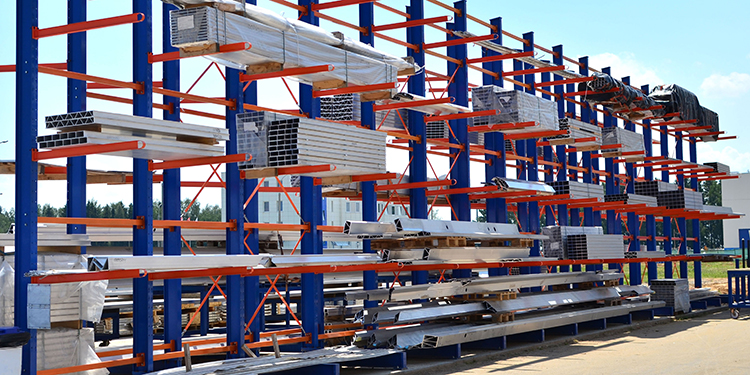Best Practices In The Safe Design And Use Of Cantilevered Storage Racks

To ensure the safe design, manufacture and installation of cantilevered rack systems, RMI publishes the ANSI MH16.3 Specification for the Design, Testing and Utilization of Industrial Steel Cantilevered Storage Racks. Designed and engineered to store very long loads — such as furniture, lumber, steel bar stock, plywood, steel sheets, sheet rock, PVC piping, metal pipes and more — cantilevered rack structures are constructed with a central, vertical column from which horizontal arms project outward. The arms extend from one or both sides of the central column. The standard, which applies to cantilevered storage racks made of cold-formed or hot-rolled steel members, includes guidance on the rack’s safe design and use. It also covers racks outfitted with accessories such as decked shelves, shed roofs and canopies.
Cantilevered rack is utilized both indoors and outside, and can be free-standing, top-tied, or integrated into the structure of the building to support the walls or roof. As with every rack system, to ensure the safe design, manufacture and installation of cantilevered rack, it is critical to engage a professional engineer with experience in racking to evaluate a variety of factors, including: installation site, soils, anchoring, load type to be stored, handling equipment, and more.
Also impacting cantilever rack design is the building’s geographic location. Seismic considerations for the rack vary depending upon the potential for damage from earthquakes in a region. Further, for outdoor application, the cantilevered rack designer will factor in the probability of an extreme snow, wind, hail or other weather event when calculating the strength and thickness of the materials specified to construct the system. These specifications will lessen the likelihood of a system collapse during an extreme weather situation.
Whether the cantilevered rack is installed indoors or outside, there are several best practices surrounding its safe use. These include:
Routine Inspections. At a minimum, a cantilevered rack should be inspected annually. However, racks that are in areas of high traffic or those that have sustained prior damage should be inspected more often. Areas to be examined include (but are not limited to) the condition of the loads in the system, the rack’s anchorage, column base plates, columns, bracing, arms and connections, and accessories. If a damaged section is discovered, the rack should be isolated and unloaded when safe to do so, then not used until the affected portions are properly repaired or replaced. Further, Section 8.5.2 of the ANSI MH16.3 standard recommends initial — as well as repeated periodic — inspection of the anchor bolt installation to verify that anchors that are part of the main force resisting system are in place and secure.
Vertical Impacts. Care must be taken when placing or removing loads so as not to create an upward or downward impact that could dislodge or disengage the arm from its connection to the column. Additionally, the ANSI MH16.3 standard Section 2.4, specifies that the arms and their connections are to be designed to withstand an additional downward impact load of 25 percent of the handled unit load, and an upward force equal to 25 percent of the load.
Load Stability. Typically, long loads are stored in cantilevered rack. As a result, they often sag under their own weight during placement or removal. To provide additional support during load insertion and extraction, the rack installation may require a special attachment or type of material handling equipment be used. Alternately, the designer may elect to incorporate additional horizontal clearance within each storage position to accommodate the sag and prevent the load from striking the arms and weakening the structure during its movement.
Aisle Clearance. As the operator navigates a load down-aisle (or parallel to the load access face of the rack), attention must be paid to the amount of horizontal clearance between the load in transit and the rack arms. Although there are no vertical columns on the aisle side of the rack structure, the tips of the arms remain exposed. This puts them at a greater risk of a collision with a load, which could compromise their capacity and cause them to fail.
Looking for more information about safe cantilevered rack design and use? Download RMI’s ANSI MH16.3 specification.


